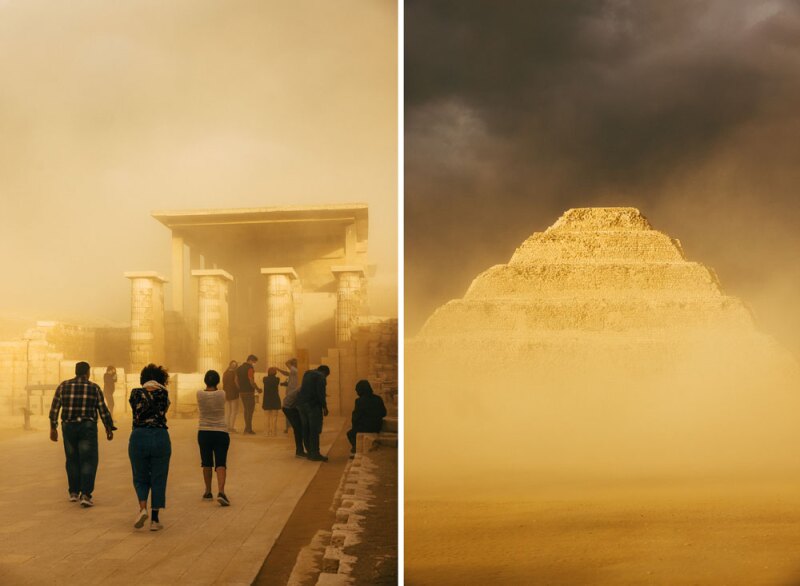People have been coming to otherworldly monuments like the Great Pyramids of Giza for thousands of years—and as a result, they’ve been overwhelmingly photographed, studied, speculated about. How can a visitor see such a well-documented attraction in a new light? On a trip to Egypt last November, I visited Giza in the company of a true pyramid pro: world-renowned archaeologist Dr. Mark Lehner, whose research and excavation projects in Egypt span nearly 40 years. On rare occasions, he offers private tours of Egypt’s pyramids and historical sights to VIPs like Bill and Melinda Gates, among other donors (past and current) to his organization, Ancient Egypt Research Associates, Inc (AERA).
I’d previously made a pilgrimage to see Egypt’s famed masonry myself, almost exactly 10 years ago (just days before the Arab Spring began). This time, with Dr. Lehner’s encyclopedic knowledge and colorful commentary and a rare rainstorm (the pyramid zone receives barely an inch of rainfall each year), my return to one of the great wonders of the world was a much richer experience.

Dr. Mark Lehner has been studying Egypt’s pyramids for decades.
Touring Giza with a pyramid pro
Dr. Lehner is as much a fixture here as the Great Sphinx of Giza. Throughout the day we were greeted warmly by an array of government officials, other Egyptologists, and guides—and sometimes allowed special access to historical sights we visited.
I met Dr. Lehner through Your Private Africa, an Africa-focused travel company he often collaborates with. The company also provides private visits to Cheops Pyramid (Great Pyramid of Khufu) and the inner legs of the Sphinx, as well as dinners, light shows, and exclusive access to tombs. In Luxor, private hot air balloon rides can also be arranged near the Valley of the Queens—an unforgettable experience.

Egyptians designed the pyramid as a petrification of the sun’s rays showing ‘pyramidally’ through breaks in the clouds.
During our tour, I asked Dr. Lehner why the ancient pharaohs built their tombs with the square base and four triangular sides that compose a pyramid, as opposed to another shape.
“One idea is that the Egyptians designed the pyramid as a petrification of the sun’s rays showing ‘pyramidally’ through a break in the clouds,” he said. “We know from The Pyramid Texts, the oldest religious literature in the world and the earliest form of writings that developed into the Book of the Dead, that they held the image of a stepped ascent to the heavens. With highly reflective white outer casings, the pyramids could be seen as stone models of sunlight, or gigantic reflectors.”
Photography isn’t allowed inside the pyramids, so I was able to relax and take in the sacred space. At one point, as we reached the King’s Chamber, Dr. Lehner spontaneously broke into a chant.
“A thousand loaves of bread, a thousand jars of beer, a thousand fold of linen,” he sang.
He was referring to the ancient texts on stelae (plaques) showing the deceased in front of a table of offerings and a list of offerings. The pharaohs placed such stelae in their tombs above the “false doors,” the symbolic entrances to the netherworld; they added a slab at the bottom of the false door in the shape of the hieroglyph for “offering” (a bread loaf on a mat). These offerings were thought to sustain the deceased in the netherworld.

From left: Lunchtime at 9 Pyramids Lounge. And did you really visit Egypt if you didn’t ride a camel?
New in 2020: a lounge at the pyramids
It’s hard to resist hiring a camel even for just a few minutes to get an iconic photo with the pyramids in the background. My main tip: Be vigilant when selecting your camel vendor and be sure to clearly agree on rates, timing, and tipping before you climb atop your new humpback friend.
Lunchtime at 9 Pyramids Lounge, the first restaurant on Egypt’s Giza Pyramids plateau that opened in October 2020, offers incredible views across the pyramid complex. The restaurant serves the typical Egyptian staples: kebabs, hummus and pita, and fresh mezze veggie plates. The best part is you no longer have to spend two-plus hours round-trip driving in and out of the pyramids for a delicious lunch anymore. Because the space is all outdoors, it’s possible to maintain social distancing even though the lounge can get very busy during mealtimes.

The Bent Pyramid in Darshur, Egypt, possibly a trial run for the Great Pyramids of Giza.
From the Giza pyramids, we drove to Darshur, about 25 miles south of Cairo, to visit the Bent Pyramid. At this point, a storm was brewing and the sky darkened.
The Bent Pyramid was the second pyramid commissioned by Sneferu, the founding pharaoh of the Fourth Dynasty of Egypt during the Old Kingdom. Sneferu’s son, Khufu, later built the Great Pyramid of Giza, so some Egyptologists believe that the Bent Pyramid may have been a “trial run” for the eventual ancient wonder of the world.

Tourists shelter from the dust storm, covering their faces with masks and shawls, at Saqqara Necropolis.
Meanwhile, a dust storm was in full effect at the Step pyramid of Djoser, part of the Saqqara Necropolis, about 19 miles outside of Cairo. The season of sandstorms, and the winds that cause them, are known as the khamasiin–the Arabic word for “fifty” for the 50 days of potential storms.
If anything, these moments only added to the drama and awe of seeing these magnificent structures in person once again.
>>Next: Get Outside in Luxor, Egypt, to Walk Among the Kings











